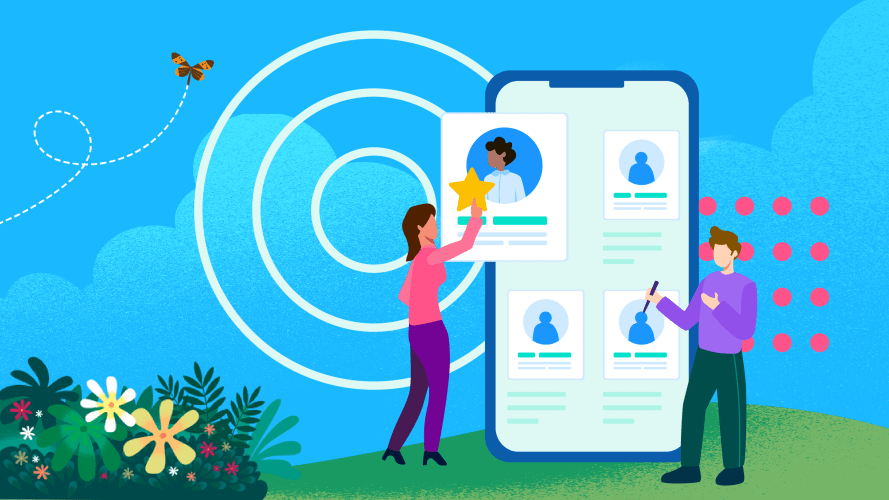If you could create your ideal customer in a lab, who would they be? Where would they work? What needs would they have that only you could help solve? What would make them so uniquely suited to your product or service that they become a lifelong customer?
These are the questions an ideal customer profile (ICP) helps sales organizations answer. So once you’ve identified your dream customer, you can start going after them.
When businesses understand exactly who their target customers are, they get rewarded. In fact, the State of Sales report found that 86% of business buyers say they’re more likely to buy when their goals are understood. But to do that, your ICP must be as specific and dialed in as possible. Let’s explore how to do this.
What you’ll learn:
Drive pipe faster with a single source of truth
Discover how Sales Cloud uses data and AI to help you manage your pipeline, build relationships, and close deals fast.



What is an ideal customer profile (ICP)?
An ideal customer profile (ICP) is a detailed description of a company that’s a perfect fit for your products or services. Of all the sales prospects in the market for your product or service, an ICP outlines the ones most likely to become paying customers.
ICPs are most commonly used in business-to-business (B2B) sales to focus a company’s sales activities on leads most likely to close. They typically combine behavioral, firmographic (information used to categorize organizations), and environmental characteristics such as industry trends, economic conditions, geographic location, and regulatory factors, to help sales and marketing teams find and concentrate on their most valuable potential customers.
The importance of defining your ICP
An ICP is important because it helps you target the companies most likely to buy your product or service. It informs everything from prospecting to qualification to pitching. The key to creating a successful ICP is specificity. You won’t find success trying to target everybody. And your audience will ignore you if you don’t speak their language.
To create an ideal customer profile, you really want to narrow it down and focus on who your customers are. The more detailed, the better. I advise a lot of companies, and almost unanimously their ideal customer profile is far too broad.
For example, consider a CEO with an ICP that includes B2B companies with 100 to 700 employees. A company with 101 employees and one with 699 has massive differences. They’re at completely different stages of maturity and levels of organization. You can’t target both with the same message. You need to narrow down your target customer so you can craft a message that perfectly captures their attention.
Don’t be afraid to get really specific. The more detailed your ICP, the more likely it is that you’ll find customers that are a good fit for your business.
Key components of an ICP
Depending on your company’s product or service, crafting an ideal customer profile requires several key components:
Demographics: Attributes of those within your target audience, including age, gender, education level, occupation, and income.
Geographic: Physical location of your target customers. Ideally, this should be as narrow as specific neighborhoods.
Psychographic: Values, interests, attitudes, and lifestyles of the target audience. This includes customer motivations and behaviors based on their personality traits, goals, and social status.
Behavioral: Customer actions and patterns, including purchasing habits, brand loyalty, product usage, and engagement levels.
Technographic: The technology stack used by the target audience, including software, hardware, and digital tools.
Firmographic: The characteristics of businesses or organizations that make up your target audience, including company size, industry, revenue, number of employees, and growth potential.
Differences between ICP and buyer persona
While ICPs and buyer personas are used in marketing and sales to define target audiences, they serve different purposes. An ICP defines the type of company that would be an ideal fit for your product or service, while a buyer persona offers a semi-fictional representation of an ideal potential customer based on research and data.
An ICP focuses on targeting the right companies, while a buyer persona focuses on understanding the people within those companies who make purchasing decisions.
ICPs can help you assess which industries and businesses are best suited for your products or services. They’re typically used when a company is developing its marketing strategy and determining its target audience. They can also be useful in account-based marketing (ABM), where a highly targeted sales approach is crucial.
Buyer personas are more specific than ICPs. They hone in on individual decision-makers or influencers at a company, outlining their role, behaviors and preferences, motivations, and pain points.
Here’s a broad ICP example for a mid-sized software as a service (SaaS) company:
100-500 employees in the e-commerce industry
Uses a CRM platform
Based in North America
And here’s a buyer persona for the same company: Jane, a 35-year-old head of operations, is responsible for optimizing workflows, prefers automated solutions, and is looking to reduce operational costs. Her pain points include inefficient systems and the need for better time management.
How to create your ideal customer profile
While there are templates available online to create ICPs, you don’t have to use any formal technology to create one. If you’re not sure where to start, take a look at your unified customer profile and ask yourself the following questions:
Who are your best customers? Review your current customer base to identify who provides the most value and is a good product market fit. Prioritize customer lifetime value (CLV), long-term relationships, and deals that can be closed with minimal obstacles.
What do your customers have in common? Identify patterns and shared characteristics among your top customers by reviewing CRM data and lead scoring analytics dashboards. These may include company size, industry, location, or common pain points.
What are the trends in your industry? Look at industry reports and trends to identify emerging markets or industries that are growing — and may have a need for your product. Research the types of companies that are using competing products to identify any gaps that your solution could address.
Common mistakes to avoid
The No. 1 mistake people make when drafting an ICP is casting too wide a net for their ideal customers. Instead of starting out broad, narrow your focus to define exactly who your ideal customer is from the start.
Some other common mistakes I’ve seen include:
Assumptions over data: Assuming what constitutes an ideal customer without proof can cost you. Use real CRM customer data — things like revenue, sales cycles, product usage, and analytics — to inform your ICP. Analyze successful clients and identify common characteristics based on facts instead of guesswork.
Not collecting feedback: Failing to gather insights from your teams is another common mistake. Your sales and customer success teams can provide valuable, firsthand insights into the behaviors, objections, and motivations of existing customers. Use this intel to refine your ICP.
Discounting pain points: Creating an ICP that ignores the specific problems your product or service helps solve is counterproductive. Instead of simply defining who your customer is with attributes like company size, industry, and revenue — consider their pain points. These may include budget constraints, poor customer support, or technical challenges with their current solution. An effective ICP should identify your customers’ challenges and highlight how your solution addresses them.
Join the Salesblazer movement
We’re building the largest and most successful community of sales professionals, so you can learn, connect, and grow.

How to use your ICP for marketing and sales
A well-crafted ICP is valuable for sales teams. It helps reps prioritize leads and focus on companies that are a great fit, shortening the sales cycle. If your ICP highlights key factors such as company size, budget, or industry, your sales teams can focus outreach and sales efforts on the best prospects. It can also help you know how to pick the right accounts.
With a clear ICP, marketing teams can develop personalized lead nurturing campaigns that speak directly to the needs and pain points of your target customers. Instead of wasting resources on broad outreach, they can zero in on specific industries, company sizes, or regions.
Lead generation also gets a boost from an ICP. By aligning ads, content marketing, and SEO with your ICP, you filter out unqualified leads and set yourself up to focus on prospects who are a better fit for your product or service. This strategy can help you attract high-quality leads that are more likely to convert.
Examples of successful ICPs
Let’s look at example ICPs for three tech industry companies to see how they narrowed down their target audience:
Company 1 ICP: A web and mobile platform designed to help teams organize, track, and manage their workflows
Size: Growing companies (50–500 employees) in industries such as tech, marketing, and consulting
Challenges: Companies that rely on team collaboration and project management tools, yet struggle with communication across departments and workflow efficiency
Needs: Companies that require help managing projects and collaborating across teams, especially in fast-paced environments
Company 2 ICP: A cloud-based messaging app and communication platform
Size: Mid-sized tech companies (50–500 employees) with distributed teams that require real-time communication and collaboration tools
Challenges: Companies that already use cloud-based tools, but are fast-growing with remote workers
Needs: Companies that require seamless, real-time communication across distributed teams
Company 3 ICP: A communications technology company primarily known for its videoconferencing application
Size: Mid-sized and large businesses (100–1,000+ employees) that operate in industries such as tech, education, and healthcare
Challenges: Companies that have geographically dispersed teams and need reliable, high-quality video conferencing solutions
Needs: Companies that look for ease of use, low maintenance, and integration with other tools
Best practices for developing your ICP
Crafting your ideal customer profile isn’t a “one-and-done” task. As your business evolves and you expand into new markets, there will be more data inputs over time that will change what you do and to whom you sell. To ensure your ICP remains effective, here are some best practices to follow:
Lead with data: Base your ICP on existing CRM data such as customer behavior, sales processes, and market research. To identify your most successful customers, look at revenue, customer lifetime value (CLV), product usage, and retention rates.
Use AI tools: Sales AI features can automate prospective account research. Summarize lead, opportunity, and other CRM data to identify the likelihood of a prospect becoming a paying customer. Pull in real-time data to understand relevant updates happening in the news that might affect your prospects and inform your ICP.
Learn from your teams: Collaborate with sales, marketing, customer success, and product teams to build a well-rounded ICP. Each team interacts with customers differently and has valuable insights you can use.
Identify pain points: Focus on the challenges your ideal customers face and how your product or service solves them. Understanding the problems your best customers experience can help reveal why they chose your solution to begin with.
Segment your customers: Create multiple ICPs to target different customer segments with varying needs. If your product can be tailored to different industries, company sizes, or use cases, consider creating separate ICPs for each segment.
Prioritize long-term value: Focus on customers with the highest potential lifetime value, rather than just those with short-term profitability. Identify which customers not only generate the most revenue but also have high retention rates and are more likely to be receptive to upselling.
Update your ICP: Your ICP should evolve with your company, market conditions, and new data. Continuously monitor your CRM data and industry trends to refine your ICP.
Drill down your ICP for higher-quality leads
A clear, data-driven ICP enables marketing and sales teams to target and close more high-value leads by focusing on the right potential customers. Don’t be afraid to get super specific to find your ideal customer. By narrowing your focus and evolving your ICP over time, you not only maximize your resources — you set your business up for long-term success.
Want to take the #1 CRM for a test drive?
Go on our Guided Tour to see how Sales Cloud boosts productivity at every stage of the sales cycle.





























